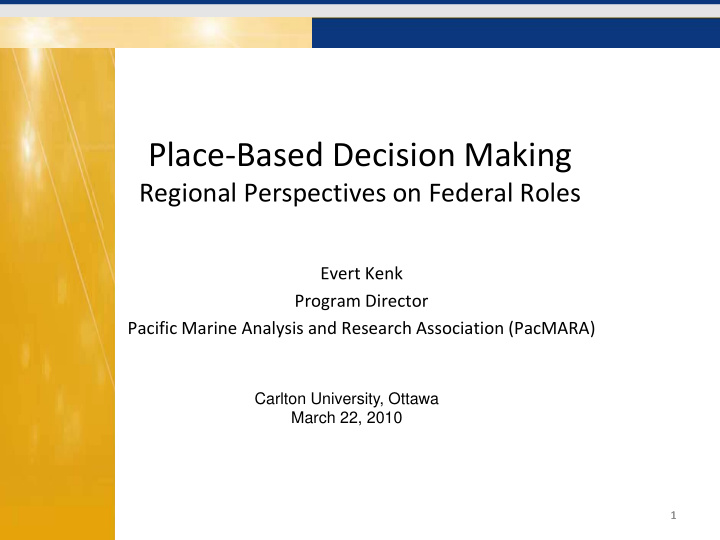



Place ‐ Based Decision Making Regional Perspectives on Federal Roles Evert Kenk Program Director Pacific Marine Analysis and Research Association (PacMARA) Carlton University, Ottawa March 22, 2010 1
ILM Data Needs Assessment • Visited four Place ‐ Based Initiatives • Humber River Valley, NL – SAR, marten • Bras d’Or Lake, NS – inland sea, pollution • Eastern Ontario Model Forest, ON – cultural heritage • Foothills Research Institute, AB – forestry, oil and gas cumulative effects on caribou • How data/information turns into knowledge for planning and decision making • Lessons learned and good practices 2
The Regional Challenge • Lack of jurisdictional clarity / well defined roles • The need to be both flexible and adaptable to regional variances • Improved data/knowledge sharing • Support for place ‐ based systems and tools 3
Lack of Jurisdictional Clarity • Issue: – Overlapping jurisdictions (private, municipal, provincial, federal) – Exacerbated by federal departmental and program overlap (DFO, EC, Agr, Trans…) and independent actions by departments • Examples: Alberta Caribou; Bras d’Or Lakes shoreline • Opportunity: – A federal (holistic) vs. departmental approach to place ‐ based management – For federal mandates (e.g. fish, SAR,…) a well defined, collaborative process for place ‐ based management 4
Flexible and Adaptable • Regional place ‐ based management is NOT uniform across the country – varies between and within provinces: – Bottom ‐ up processes: Foothills Research Institute, Bras d’Or Lakes – informal (not legislated) governance – Top ‐ down processes: BC LRMP process, Alberta LUF/RAC process – formal (legislated) governance • Federal approach to place ‐ based management needs to be flexible and adaptable, “one size” does not fit all – but still needs to be well defined 5
Improved Data/Knowledge Sharing • Issues: – Access to federal place ‐ based data holdings is still a challenge (both finding and retrieving) – Access to federal research and project place ‐ based data products is still a challenge (both finding and retrieving) • Need to look at Opportunties: – Research/project ‐ based extension and outreach for better uptake – including collaboration when it makes sense – Opening up internal place ‐ based applications/tools to regional partners – Geospatially enabling federal social/economic data for integration into place ‐ based management processes (StatsCan data was structured for urbanscapes but not landscapes (watersheds) 6
Support for Place ‐ based Systems and Tools • National (vs. federal) place ‐ based programs and systems have had notable successes: – Programs: GeoConnections, Agriculture Policy Framework CLI/BCLI (meeting regional/local needs) – Systems: Geographic Names, Species at Risk, CanSIS… (meeting national information/knowledge needs) • Need to compare with place ‐ based programs and systems that did not have national uptake: CISE, NLWIS • Data and standards are in place – need desktop and group tools that support place ‐ based decision making (policy, planning, operational levels) 7
What really works for regional place ‐ based management? • Bottom ‐ up informal processes – Participation, collaboration and building trust • Top ‐ down formal processes – Engagement [vs. consultation] with workable well ‐ defined processes • Goal or Target Visions – Improving Quality of Life (Well ‐ being) meaning a positive balance • Society, Culture, Economy and Environment 8
Recommend
More recommend